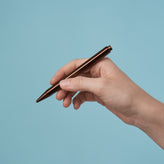Brodie Larocque answered the call of the wild. The Arctic adventurer shares stories from his life working at the Canadian High Arctic Research Station, how he uses his paper republic journal to sketch moose and muskox, and how he’s turning his Arctic experiences into ‘dad lore’ for his kids…

How did you end up living and working in the Arctic?
I'm originally from Gatineau, Quebec, right next to the capital: Ottawa. I always wanted to have adventures but I started my career in government. Living close to the capital, that’s what most of my peers did. But then I applied for a role in a mine up in Nunavut – the vast, northernmost territory of Canada – a place with a polar climate.
And I just fell in love with the north. After that experience, I returned down south but set my sights on getting back up to the Arctic more permanently. I searched for jobs, filtering only for opportunities in Nunavut. I just wanted to be up there. I didn't care what I was doing. Because I knew that up there, I could live all the adventures I wanted to live.
Eventually a job opening appeared to manage the communications team at the Canadian High Arctic Research Station. I jumped on it. My spouse and I sold all our possessions, she quit her job, we said bye to our friends and family, and we moved up north. We've been living here just shy of three years now.

What does that job entail? Tell us about a typical day in the Canadian arctic.
In summer, I wake up in the morning and start the ATV. Almost no one up here uses a car. Most people own ATVs, and snowmobiles for the winter, and some own trucks. I head out to the Research Station – a short ATV ride from where we live.
A large part of my role is sharing the work of the researchers up here. Our team spends time out on the land with them, photographing and filming them doing fieldwork. I also handle internal communication at the station. Plus, I take care of all the visitors we have.
In my personal time I can’t keep myself away from participating more directly in the science: drilling ice cores, checking ice thickness, or collecting water samples for example. It is fulfilling to participate in bettering our understanding of the circumpolar regions.

How do your paper republic journals help with your life and work in the Arctic?
When I was younger, I journaled for self-medication. Every time something was overwhelming or negative, I would write about it in my journal. I called it my ‘black book’, because it was full of bad feelings.
More recently, I wanted to use journalling to record my positive experiences; a way to remember all the good times and the adventures. A journal I could even give to my kids one day.
I have two notebooks that I separate with the card and cash holder. The first is plain book and I use it for doodling. Whenever I see cool things out on the land – muskox, caribou or birds for example – I draw them. In my second notebook I have lined paper and I write down my Arctic experiences. I try to record something every week or so.

Why did you choose a paper republic journal?
I had been looking for a leather journal for so long, and yours looked really high quality. What I liked the most was the patina and how you showed before and after shots of the leather aging. It looked very beautiful and I thought: wow, this thing could age with me!
I liked that I could get it embossed, and that everything was handmade. I also liked the story behind paper republic and that it was a little piece of Vienna.
So all that connected with me. I take it on all my adventures. I like how it has patinated in my bag. I'm at peace if it gets wet or mangled up. It's rugged like me! Having the journal allows me to relive my adventures later.
We all have experiences in our heads, but to write them down is to immortalize them. I wanted to have something to show my kids; I call it ‘dad lore’. I hope one day they'll read it and understand what it means to chase your dreams.

What is it about the Arctic that you love so much?
I had a kind of a spiritual moment when I was first working at the mine up here. On the mining site, there are very strict rules about accessing Inuit land. We weren't allowed to step foot on the tundra. So I walked as far as the gravel path would allow, to get as far from the base as possible. Then I just looked out over this vast stretch of untouched land; just wide-open space. I had never seen anything like it.
Down south you see buildings, or roads or some evidence that humans are there. But up here, once you go three, four kilometers out of town, there’s absolutely none of that. The untouched beauty really drew me in.
I also love the lifestyle. Lots of fishing, hunting, camping, and travelling across the land. And a culture of making your own clothes by hand: parkas, mitts, boots – all made from animal hides, fur and leather. We are more connected to nature here. There’s also a very strong community. Whenever you pass a truck or another ATV, everybody waves. You go to the grocery store or the post office and it's like a social club. It’s very close-knit. You need to know each other to survive up here.

Why do you use paper pen, as opposed to just opening a laptop and writing your notes in there?
I have tried to use Notion. I have even tried this ‘remarkable’ tablet where you can write with the same feeling as paper. But real paper and a real pen just feels more satisfying. Our world is so technology based now. Everybody has a computer in their pocket, myself included. I spend my days on a computer. But writing in a journal with a pen almost feels religious or spiritual; to have that moment with myself.
What do you do in your time off?
I love to fish. Arctic char is the most prized fish up here. There's also cod in the ocean. I eat a lot of char. My friend manages the fish plant and last time we went fishing he brought a bunch of double-smoked, jalapeno char jerky. It was exquisite. I also love to explore the ice, go camping, and go out with the hunters who stalk moose, caribou and muskox.

Do you see polar bears?
Yes. I have accompanied my friends on many polar bear hunts on the sea ice around Victoria Island. The ice there can form this crazy landscape, where ice plaques collide and create walls of ice six feet high. It makes for really rough travelling terrain; it’s minus 30, you're freezing, and you're carrying all your gear on a wooden sled. And you have to watch for polar bears. You're trying to see them before they see you. It’s pretty exciting.
Do you speak the local Inuit language?
Everyone speaks English here, but there’s also the local language: Inuinnaqtun. Sadly, it’s a dying tongue, but most of the elders still speak it, which is a real treat to hear. I have been learning Inuinnaqtun words from them for the wildlife and all the different snow and ice conditions. Alappaa means it’s cold. I use that one a lot!

Is there anything you miss about life down south?
Not really. Last March I went to Ottawa for a few weeks. Back to the hustle and bustle, the traffic, the people caring about what you're wearing and all that. But it drained me. I got instantly stressed. I felt overstimulated. Up here, people don't care about what you're wearing. They care about the content of your character, if you keep your word, if you are willing to learn.
Down south, I feel life is more individualistic. People are more focused on themselves and living their own lives. But what I do miss is having a barber. I haven't cut my hair since March! That’s why I wear a hat all the time, just trying to keep it tame.
Of course, I do miss my family. I miss my mom. I miss my friends too. I feel like I'm missing out on their lives which stings a little bit. But if I zoom out and I look at it from a macro perspective, I miss only 10% of life down south.
The rest is pure adventure.



![[pocket] / reef / plain | [pocket] / récif / blanches | [pocket] / Ozean / blanko | [pocket] / Barriera corallina / pagine bianche](http://www.paper-republic.com/cdn/shop/files/06_PR_DYBDHAL_MAY_Square_014_53e26280-f35c-49f6-87ef-4549c61bc5fe.jpg?v=1715667555&width=164)
